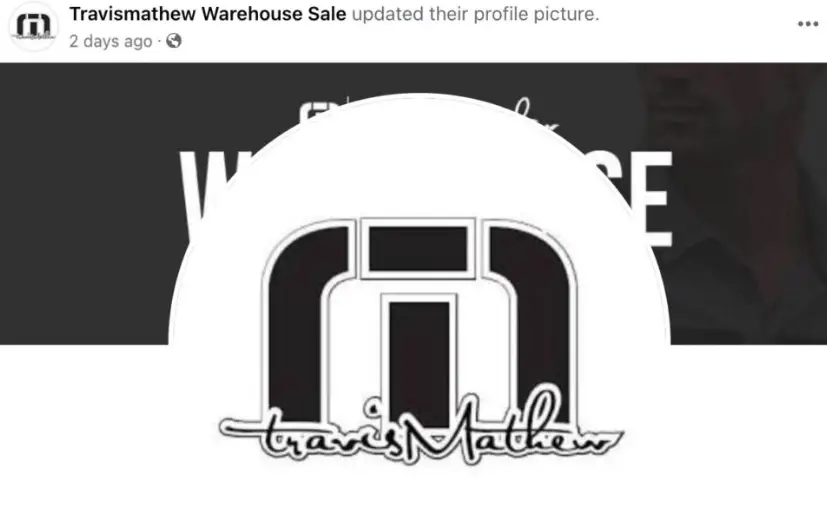The Travis Mathew Warehouse Sale Scam on social media is a recent trending scam set up by scammers impersonating the Travis Mathew Brand. Have you come across these Ads on Facebook or Instagram and want to find out if it is a scam or legit? Read this review to know more!
What Is The Travis Mathew Warehouse Sale Scam?

The Travis Mathew Warehouse Sale Scam is a fraudulent scheme where scammers impersonate the Travis Mathew brand to deceive consumers into believing they are purchasing discounted merchandise from a legitimate warehouse sale.
How The Travis Mathew Warehouse Sale Scam Works
The Travis Mathew Warehouse Sale Scam works with Fake websites and Social media Ads, The scammers create fake websites and online ads that mimic the official Travis Mathew site or use similar branding to appear legitimate. These sites often advertise low discounts on Travis Mathew products, such as clothing and accessories, luring customers with seemingly great deals. Some examples of these fraudulent websites are: Figaceous.com, erritor.com, which were all recently created in April 2024.
They also use Ads which appear on social media platforms like Facebook and Instagram, or through email campaigns, claiming to offer limited-time sales on popular Travis Mathew items. Then they move on with enticing and too good to be true offers, For example, products may be advertised at 50-70% off, creating a sense of urgency and appealing to bargain hunters. They also use also use countdown timers or other tactics to pressure customers into making quick purchases without thoroughly vetting the site’s authenticity. They also use fake checkout and payment processes. Once customers attempt to purchase items, they are directed to a checkout process that captures their payment information. These sites usually accept payments through credit cards, which the scammers use to steal financial details. After the purchase, customers often find it impossible to contact customer support or get a refund. The fake sites generally have no legitimate customer service channels, making it difficult to resolve issues or reclaim lost money.
How To Identify The Scam Travis Mathew Warehouse Sale Websites:
Some of the Red and warning flags include:
- Unusually Low Prices
- The fake sites often have URLs that are slightly different from the official site, such as minor misspellings or additional words (e.g., “travis-mathew-sale.com” instead of “travismathew.com”).
- Lack of secure payment methods
- No customer support
- No contact Information
What To Do If You Have Been Scammed
If you have been scammed by an online store, it’s essential to take immediate action to minimize further damage and increase the chances of resolving the issue. Here are the steps to follow:
Contact the Online Store:
The first step is to try to resolve the issue directly with the online store. Look for contact information on their website, such as a customer support email or phone number, and reach out to them. Explain the situation, including details of the transaction, the product or service you purchased, and any issues or discrepancies.
Gather Evidence:
Document all communication with the online store, including screenshots, emails, order confirmations, and receipts. This evidence will be crucial if you need to escalate the matter or dispute the charge with your payment provider.
Check Your Payment Method:
Depending on how you paid for the purchase (credit card, debit card, PayPal, etc.), contact your payment provider and inform them of the situation. They may be able to help you initiate a chargeback or dispute the transaction
Review the Online Store’s Policies:
Familiarize yourself with the online store’s return, refund, and dispute resolution policies. Some stores may have a specific process for handling issues and providing refunds.
Report the Scam;
Report the scam to relevant authorities and organizations. This includes:
- Internet Crime Complaint Center (IC3): If you are in the United States, you can file a complaint with the IC3 at https://www.ic3.gov/.
- Your Local Consumer Protection Agency: Contact your local consumer protection agency or the equivalent regulatory body in your country.
- Better Business Bureau (BBB): File a complaint with the BBB if the online store is based in the United States.
Monitor Your Accounts:
Keep a close eye on your bank and credit card statements for any unauthorized or suspicious transactions. Report them to your financial institution immediately.
Change Your Passwords:
If you created an account on the scam website, change your passwords for that account and any other accounts where you used similar login credentials.
Educate Yourself:
Use this experience as a learning opportunity. Be more cautious when shopping online and always verify the legitimacy of online stores before making a purchase. Look for reviews, check for trust seals, and ensure the website uses secure, encrypted connections (https://).
Remember that it may not always be possible to recover your money, but by taking these steps, you increase your chances of resolving the issue and preventing future scams. Additionally, always trust your instincts and be cautious when dealing with unfamiliar online stores or offers that seem too good to be true.
Conclusion
The Travis Mathew Warehouse Sale Scam exemplifies how scammers exploit popular brands to deceive consumers. By staying vigilant and following the steps outlined above, you can protect yourself from falling victim to these fraudulent schemes. To protect your hard-earned money and personal information, it’s essential to steer clear of too good to be true offers and opt for reputable and trustworthy online retailers instead. Remember, if a deal seems too good to be true, it probably is.
